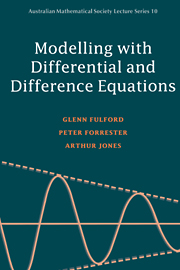Book contents
- Frontmatter
- Contents
- Preface
- Introduction to the student
- Part One Simple Models in Mechanics
- Part Two Models with Difference Equations
- Part Three Models with Differential Equations
- 11 Continuous growth and decay models
- 12 Modelling heat flow
- 13 Compartment models of mixing
- Part Four Further Mechanics
- Part Five Coupled Models
- References
- Index
11 - Continuous growth and decay models
Published online by Cambridge University Press: 05 June 2012
- Frontmatter
- Contents
- Preface
- Introduction to the student
- Part One Simple Models in Mechanics
- Part Two Models with Difference Equations
- Part Three Models with Differential Equations
- 11 Continuous growth and decay models
- 12 Modelling heat flow
- 13 Compartment models of mixing
- Part Four Further Mechanics
- Part Five Coupled Models
- References
- Index
Summary
In this chapter some problems of growth and decay will be studied for which differential equations, rather than difference equations, are the appropriate mathematical models. Such problems include:
the growth of large populations in which breeding is not restricted to specific seasons,
the absorption of drugs into the body tissues,
the decay of radioactive substances.
The differential equations which arise from the above problems are all of the first order. The two methods of solution which we explain are sufficient to solve all the differential equations which arise in the next three chapters. The theoretical background for these two methods is contained in Chapter 5. The first of the two methods, which applies only to linear differential equations, is very similar to the method already given in Section 8.1 for solving linear difference equations. The continuous models used in this chapter are similar to the discrete models discussed in Chapter 9.
First-order differential equations
The two types of differential equations which you need to be able to solve in this chapter are called linear with constant coefficients and variables separable differential equations. The former arise from problems of unrestricted growth, while the latter appear when the growth is restricted. How to recognize and solve the two types of differential equations will now be explained.
- Type
- Chapter
- Information
- Modelling with Differential and Difference Equations , pp. 203 - 231Publisher: Cambridge University PressPrint publication year: 1997

